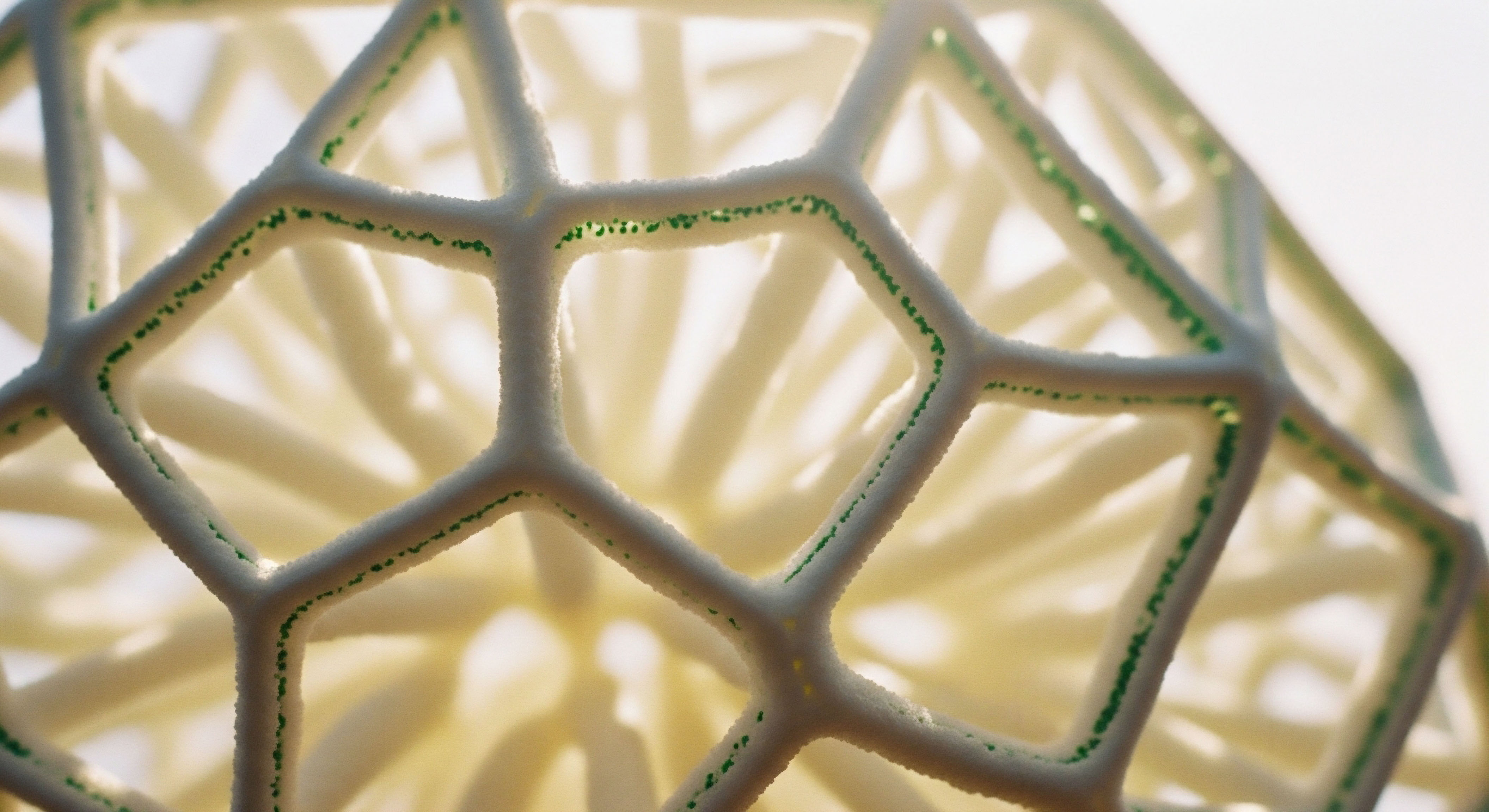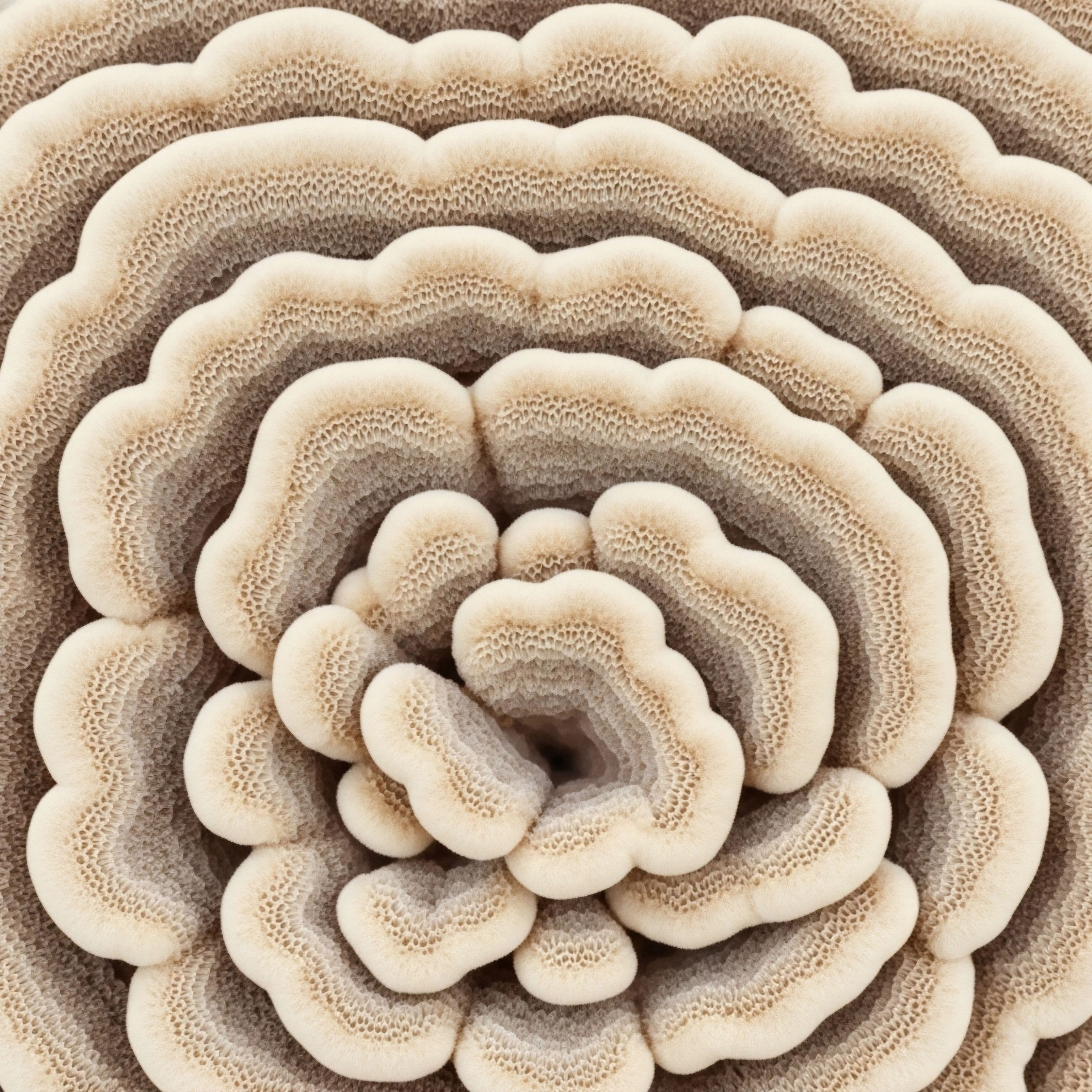

Fundamentals
The moment an injury occurs, a complex biological narrative begins to unfold within your body. The pain, swelling, and loss of function you experience are the outward signs of an intricate, microscopic process of deconstruction and rebuilding. When you embark on a physical rehabilitation program, you are actively participating in this process, guiding your body back toward strength and mobility.
The journey of recovery, however, is often dictated by the efficiency of your internal repair crews. Integrating peptide therapy into this process introduces a powerful set of tools designed to augment your body’s innate healing capabilities, potentially transforming the timeline and quality of your recovery.
Peptides are short chains of amino acids, which are the fundamental building blocks of proteins. Think of them as precise, biological messengers. Each peptide has a specific structure that allows it to communicate a very particular instruction to your cells.
In the context of healing, certain peptides can signal cells to accelerate tissue regeneration, manage inflammation, and construct new blood vessels to deliver vital nutrients to the site of an injury. This cellular-level communication is where the synergy with physical rehabilitation begins. While physical therapy works to restore macroscopic function through movement and targeted stress, peptide therapy works at the microscopic level to ensure the building blocks for that function are available and assembled efficiently.

The Cellular Foundation of Recovery
When you tear a muscle or strain a ligament, your body initiates a cascade of events. Inflammation is the first response, bringing immune cells to the area to clear out damaged tissue. Following this, specialized cells called fibroblasts begin to produce collagen, the primary protein that forms the structural matrix of your connective tissues.
The quality and speed of this collagen synthesis are critical determinants of how well you heal. A disorganized or slow healing process can lead to scar tissue that is weaker and less flexible than the original tissue, increasing the risk of re-injury.
Peptide therapies can directly influence these core processes. For instance, a peptide known as BPC-157 has been observed in preclinical studies to promote the outgrowth of fibroblasts and enhance their survival under stress. Another peptide, TB-500 (a synthetic version of Thymosin Beta-4), plays a role in upregulating proteins like actin, which is crucial for cell migration and the formation of new tissue.
By supporting these foundational biological actions, peptide therapy creates a more robust internal environment for healing, allowing the mechanical stresses of physical therapy to be more productive.
Peptide therapy provides targeted biological signals that can enhance the cellular repair mechanisms underlying physical recovery.
The integration of these two modalities represents a shift toward a more comprehensive model of rehabilitation. It acknowledges that true recovery is a multi-scale process. The exercises you perform in a physical therapy session are essential for guiding the alignment and strength of new tissue, while peptide protocols can ensure that the tissue itself is being built with optimal speed and integrity.
This combined approach views the body as an interconnected system, where targeted biochemical support can amplify the benefits of mechanical rehabilitation, leading to a more complete and resilient recovery.


Intermediate
Advancing beyond the foundational understanding of peptides as cellular messengers, we can examine the specific mechanisms through which these molecules can be integrated with traditional physical rehabilitation programs. The synergy between peptide therapy and physical therapy is grounded in the targeted biological actions of specific peptides, which can create an optimized physiological environment for healing.
This allows the mechanical stresses introduced by physical therapy to translate more effectively into functional recovery. Two of the most well-researched peptides in the context of tissue repair are BPC-157 and TB-500.

Protocols for Tissue Regeneration
The application of peptide therapy in a rehabilitation setting is protocol-driven, tailored to the specific type and phase of injury. The goal is to match the biological effects of the peptide with the physiological needs of the healing tissue.
For instance, in the acute phase of an injury, characterized by inflammation and pain, the anti-inflammatory properties of certain peptides can be particularly beneficial. As the rehabilitation process moves into the sub-acute and chronic phases, the focus shifts to promoting tissue regeneration and remodeling, which is where the pro-angiogenic and collagen-stimulating effects of peptides become paramount.

BPC-157 Angiogenesis and Fibroblast Recruitment
BPC-157, a pentadecapeptide derived from a protein found in gastric juice, has demonstrated significant pro-healing capabilities in preclinical studies. Its primary mechanism of action involves the promotion of angiogenesis, the formation of new blood vessels. This is a critical step in tissue repair, as new blood vessels are required to deliver oxygen, nutrients, and growth factors to the injury site.
BPC-157 has been shown to stimulate the expression of Vascular Endothelial Growth Factor Receptor 2 (VEGFR2), a key player in the angiogenic signaling cascade. By enhancing blood supply to the damaged area, BPC-157 can accelerate the removal of cellular debris and provide the necessary resources for tissue reconstruction.
Furthermore, BPC-157 has been shown to accelerate the migration and spreading of fibroblasts, the cells responsible for producing collagen. This is achieved through the activation of the FAK-paxillin pathway, a signaling cascade that governs cell movement and adhesion.
An increased presence of fibroblasts at the injury site leads to more efficient collagen deposition, which is the cornerstone of tendon and ligament repair. When combined with physical therapy, which helps to align these newly formed collagen fibers, the result is a healed tissue that more closely resembles its original, uninjured state in terms of both strength and flexibility.

TB-500 Cell Migration and Actin Upregulation
TB-500 is the synthetic counterpart to Thymosin Beta-4, a naturally occurring peptide that plays a vital role in tissue repair and regeneration throughout the body. One of its key functions is the upregulation of actin, a protein that is essential for cell structure and movement.
By promoting actin polymerization, TB-500 facilitates the migration of cells to the site of injury, a process known as chemotaxis. This includes the migration of endothelial cells, which form the lining of blood vessels, and myoblasts, which are the precursors to muscle cells. This makes TB-500 particularly effective for muscle strains and tears.
In addition to its role in cell migration, TB-500 has potent anti-inflammatory properties. It can modulate the immune response, reducing the production of pro-inflammatory cytokines while promoting the release of anti-inflammatory molecules. This helps to control the initial inflammatory phase of healing, which can otherwise lead to excessive pain, swelling, and secondary tissue damage.
By mitigating inflammation and promoting the migration of reparative cells, TB-500 creates an internal environment that is conducive to the healing processes stimulated by physical rehabilitation.
The strategic use of peptides like BPC-157 and TB-500 can address specific biological bottlenecks in the healing process, such as poor blood flow or slow cell migration.

How Can Peptides Augment Physical Therapy Outcomes?
The integration of peptide therapy into a physical rehabilitation plan is a targeted intervention designed to enhance the body’s response to therapeutic exercise. The peptides do not replace the need for physical therapy; they amplify its effects. For example, a patient recovering from an Achilles tendon repair might undergo a physical therapy protocol focused on progressive loading to stimulate collagen remodeling.
The concurrent use of BPC-157 could enhance the supply of fibroblasts and collagen precursors to the tendon, providing the raw materials needed for the remodeling process. This could potentially lead to a faster recovery of tensile strength and a reduced risk of re-rupture.
Similarly, an athlete with a hamstring strain might engage in physical therapy exercises designed to restore muscle flexibility and strength. The addition of TB-500 to their recovery protocol could accelerate muscle fiber regeneration and reduce the formation of scar tissue. This could result in a more complete return to function and a lower likelihood of chronic hamstring issues.
The key is to view peptide therapy as a biological tool that can be used to prepare the tissue for the mechanical demands of rehabilitation, creating a more efficient and effective healing process.
| Rehabilitation Phase | Physiological Goal | Potential Peptide Intervention | Synergistic Outcome |
|---|---|---|---|
| Acute (0-72 hours) | Inflammation Control | TB-500 | Reduced swelling and pain, allowing for earlier initiation of gentle movement. |
| Sub-acute (3-21 days) | Angiogenesis and Fibroblast Proliferation | BPC-157 | Enhanced delivery of nutrients and building blocks for tissue repair. |
| Chronic (21+ days) | Collagen Remodeling and Tissue Maturation | BPC-157, GHK-Cu | Improved tissue quality and tensile strength in response to progressive loading. |
- BPC-157 has been shown in animal studies to accelerate the healing of various tissues, including tendons, ligaments, and bone.
- TB-500 is known for its ability to promote cell migration, reduce inflammation, and stimulate the formation of new blood vessels.
- GHK-Cu, a copper peptide, is recognized for its role in collagen synthesis and skin regeneration.


Academic
From an academic perspective, the integration of peptide therapy with physical rehabilitation represents a sophisticated application of regenerative medicine principles. This approach leverages the specific molecular signaling of therapeutic peptides to modulate the cellular and extracellular environment in a way that potentiates the mechanotransductive stimuli of physical therapy.
The central hypothesis is that by optimizing the biological substrate of healing, we can achieve a more robust and accelerated functional recovery. This discussion will delve into the molecular mechanisms of key peptides, particularly BPC-157 and TB-500, and explore their synergistic potential with mechanotherapy from a systems-biology standpoint.

Molecular Mechanisms and Systemic Effects
The therapeutic potential of peptides in rehabilitation is rooted in their ability to interact with specific cellular pathways that are fundamental to tissue repair. These are not blunt instruments; they are highly specific signaling molecules that can influence everything from gene expression to protein synthesis. Understanding these mechanisms is essential for their rational application in a clinical setting.

The FAK-Paxillin Axis and BPC-157
One of the most compelling aspects of BPC-157 is its influence on the Focal Adhesion Kinase (FAK) signaling pathway. FAK is a non-receptor tyrosine kinase that plays a central role in cell adhesion, migration, and proliferation. Upon activation, FAK phosphorylates several downstream targets, including paxillin, which then recruits other proteins to form focal adhesions.
These structures are critical for linking the cell’s internal actin cytoskeleton to the extracellular matrix, allowing the cell to sense and respond to mechanical cues. Preclinical studies have shown that BPC-157 can dose-dependently increase the phosphorylation of both FAK and paxillin in tendon fibroblasts.
This enhanced activation of the FAK-paxillin axis is believed to be the primary mechanism behind BPC-157’s ability to accelerate fibroblast migration and outgrowth from tendon explants. This has profound implications for rehabilitation, as the efficiency of fibroblast migration to the injury site is a rate-limiting step in tendon and ligament healing.

Actin Dynamics and Thymosin Beta-4
Thymosin Beta-4 (and its synthetic analog, TB-500) exerts its primary effects through its interaction with G-actin, the monomeric form of actin. By sequestering G-actin monomers, Thymosin Beta-4 maintains a cytoplasmic pool of actin that can be rapidly mobilized for polymerization into F-actin filaments.
This process is fundamental to cell motility, as the dynamic assembly and disassembly of the actin cytoskeleton drives the formation of lamellipodia and filopodia, the structures that allow cells to “crawl” to their destination. In the context of wound healing, this means that TB-500 can facilitate the migration of endothelial cells for angiogenesis, keratinocytes for re-epithelialization, and fibroblasts for collagen deposition.
Furthermore, TB-500 has been shown to have a cardioprotective effect after myocardial infarction, partly by promoting the survival and migration of cardiac progenitor cells. This highlights the systemic and pleiotropic nature of its regenerative potential.
The targeted modulation of signaling pathways like the FAK-paxillin axis and actin dynamics represents a sophisticated strategy for enhancing the biological response to mechanotherapy.

What Is the Future of Integrated Rehabilitation?
The future of integrated rehabilitation lies in the development of personalized protocols that combine specific peptide therapies with tailored physical therapy regimens. This will require a deeper understanding of the temporal dynamics of healing and the specific molecular signatures of different injury types.
For example, the optimal timing and dosage of a pro-angiogenic peptide like BPC-157 may differ for an acute muscle tear versus a chronic tendinopathy. The development of advanced diagnostic tools, such as biomarker assays that can quantify the expression of key growth factors and signaling molecules in real-time, will be instrumental in guiding these personalized interventions.
Furthermore, the exploration of novel peptide combinations and delivery systems holds significant promise. The synergistic effects of combining a pro-angiogenic peptide with a molecule that promotes collagen synthesis, for instance, could lead to even more impressive regenerative outcomes.
The development of hydrogel-based delivery systems that can provide a sustained, localized release of peptides at the injury site could also enhance their efficacy while minimizing potential systemic side effects. As our understanding of the intricate biology of tissue repair continues to grow, so too will our ability to harness the power of peptides to create a new paradigm of regenerative rehabilitation.
| Peptide | Primary Molecular Target/Pathway | Cellular Effect | Relevance to Physical Rehabilitation |
|---|---|---|---|
| BPC-157 | FAK-Paxillin Pathway, VEGFR2 | Increased fibroblast migration, angiogenesis | Accelerates tendon/ligament healing, enhances nutrient supply |
| TB-500 | G-actin Sequestration | Enhanced cell motility, anti-inflammatory | Promotes muscle regeneration, reduces post-injury inflammation |
| Sermorelin/Ipamorelin | Growth Hormone Secretagogue Receptor (GHSR) | Increased IGF-1 production, protein synthesis | Systemic anabolic support for tissue growth and repair |
| GHK-Cu | Collagen and Elastin Gene Expression | Stimulates extracellular matrix production | Improves skin and connective tissue quality, reduces scar formation |
- Growth Hormone Secretagogues like Sermorelin and Ipamorelin can be used to augment the systemic anabolic environment, which is beneficial for overall tissue repair and recovery.
- Pentadeca Arginate (PDA) is another peptide with potential applications in tissue repair, particularly due to its anti-inflammatory and pro-healing properties.
- PT-141, while primarily known for its effects on sexual health, also has broader implications for neurotransmitter function and systemic well-being, which can indirectly support the recovery process.

References
- Chang, C. H. Tsai, W. C. Hsu, Y. H. & Pang, J. H. (2011). The promoting effect of pentadecapeptide BPC 157 on tendon healing involves tendon outgrowth, cell survival, and cell migration. Journal of Applied Physiology, 110(3), 774-780.
- Staresinic, M. Petrovic, I. Novinscak, T. Brcic, L. Boban-Blagaic, A. Batelja, L. & Sikiric, P. (2006). Effective therapy of transected quadriceps muscle in rat ∞ gastric pentadecapeptide BPC 157. Journal of Orthopaedic Research, 24(5), 1109-1117.
- Goldstein, A. L. Hannappel, E. & Kleinman, H. K. (2005). Thymosin β4 ∞ a multi-functional regenerative peptide. Expert opinion on biological therapy, 5(9), 1237-1245.
- Philp, D. & Kleinman, H. K. (2010). Thymosin β4 and the vasculature ∞ role in development, repair, and protection against inflammatory-mediated injury. Annals of the New York Academy of Sciences, 1194(1), 83-89.
- Brcic, L. Brcic, I. Staresinic, M. Novinscak, T. Sikiric, P. & Seiwerth, S. (2009). Modulatory effect of gastric pentadecapeptide BPC 157 on angiogenesis in muscle and tendon healing. Journal of physiology and pharmacology, 60(Suppl 7), 191-196.
- Hsieh, M. J. Lee, C. H. Chueh, H. Y. & Pang, J. H. S. (2017). Pentadecapeptide BPC 157 enhances the growth hormone receptor expression in tendon fibroblasts. Molecules, 22(7), 1105.
- Tvrdeić, A. Gojković, S. Krezic, I. Zukan, M. Madzar, Z. Sikiric, S. & Sikiric, P. (2020). Stable gastric pentadecapeptide BPC 157 and transforming growth factor-beta1. Biomedicines, 8(11), 478.
- Khavinson, V. K. & Popovich, I. G. (2020). Peptides, genome, and aging. Gerontology, 66(4), 327-332.
- Re, L. & Re, K. (2020). Peptides and skin regeneration. Journal of cosmetic dermatology, 19(9), 2199-2205.
- De-min, W. Zhen, C. Li, L. Ping, Z. & Xian-guo, L. (2017). The effect of thymosin beta 4 on the regeneration of transected sciatic nerve in rats. Neuroscience letters, 645, 82-89.

Reflection

Charting Your Own Path to Recovery
The information presented here offers a window into the evolving landscape of regenerative medicine and its potential to reshape our approach to healing. Understanding the science behind how your body repairs itself is the first step on a journey toward proactive wellness.
The integration of targeted biological interventions like peptide therapy with the established principles of physical rehabilitation represents a powerful convergence of disciplines. This knowledge equips you to ask more informed questions and to view your own recovery not as a passive waiting period, but as an active process that you can influence.
Your personal health journey is unique, shaped by your individual biology, the nature of your injury, and your specific goals. The path to optimal recovery is one of partnership, a collaboration between you and your healthcare providers. The true potential of these advanced therapies is unlocked when they are applied within a personalized framework, tailored to your body’s specific needs.
As you move forward, consider how this deeper understanding of your own biological systems can empower you to take a more central role in your own healing, transforming the process from one of simple repair to one of profound restoration and enhanced resilience.

Glossary

physical rehabilitation

peptide therapy

tissue regeneration

collagen synthesis

cell migration

bpc-157

bpc-157 and tb-500

tissue repair

angiogenesis

fak-paxillin pathway

tb-500

regenerative medicine

mechanotherapy

fibroblast




